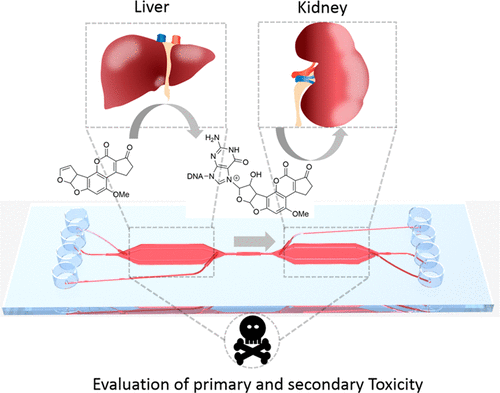当前位置:
X-MOL 学术
›
ACS Biomater. Sci. Eng.
›
论文详情
Our official English website, www.x-mol.net, welcomes your feedback! (Note: you will need to create a separate account there.)
Liver-Kidney-on-Chip To Study Toxicity of Drug Metabolites
ACS Biomaterials Science & Engineering ( IF 5.8 ) Pub Date : 2017-12-04 00:00:00 , DOI: 10.1021/acsbiomaterials.7b00417 Jannick Theobald 1 , Ali Ghanem 1 , Patrick Wallisch 1 , Amin A. Banaeiyan 2 , Miguel A. Andrade-Navarro 3 , Katerina Taškova 3 , Manuela Haltmeier 4 , Andreas Kurtz 5 , Holger Becker 6 , Stefanie Reuter 7 , Ralf Mrowka 7 , Xinlai Cheng 1 , Stefan Wölfl 1
ACS Biomaterials Science & Engineering ( IF 5.8 ) Pub Date : 2017-12-04 00:00:00 , DOI: 10.1021/acsbiomaterials.7b00417 Jannick Theobald 1 , Ali Ghanem 1 , Patrick Wallisch 1 , Amin A. Banaeiyan 2 , Miguel A. Andrade-Navarro 3 , Katerina Taškova 3 , Manuela Haltmeier 4 , Andreas Kurtz 5 , Holger Becker 6 , Stefanie Reuter 7 , Ralf Mrowka 7 , Xinlai Cheng 1 , Stefan Wölfl 1
Affiliation

|
Advances in organ-on-chip technologies for the application in in vitro drug development provide an attractive alternative approach to replace ethically controversial animal testing and to establish a basis for accelerated drug development. In recent years, various chip-based tissue culture systems have been developed, which are mostly optimized for cultivation of one single cell type or organoid structure and lack the representation of multi organ interactions. Here we present an optimized microfluidic chip design consisting of interconnected compartments, which provides the possibility to mimic the exchange between different organ specific cell types and enables to study interdependent cellular responses between organs and demonstrate that such tandem system can greatly improve the reproducibility and efficiency of toxicity studies. In a simplified liver-kidney-on-chip model, we showed that hepatic cells that grow in microfluidic conditions abundantly and stably expressed metabolism-related biomarkers. Moreover, we applied this system for investigating the biotransformation and toxicity of Aflatoxin B1 (AFB1) and Benzoalphapyrene (BαP), as well as the interaction with other chemicals. The results clearly demonstrate that the toxicity and metabolic response to drugs can be evaluated in a flow-dependent manner within our system, supporting the importance of advanced interconnected multiorgans in microfluidic devices for application in in vitro toxicity testing and as optimized tissue culture systems for in vitro drug screening.
中文翻译:

肝肾芯片研究药物代谢物的毒性
片上器官技术在体外药物开发中的应用进展,为替代有争议的动物试验并为加速药物开发奠定了基础,提供了一种有吸引力的替代方法。近年来,已经开发了各种基于芯片的组织培养系统,这些系统大多针对单个细胞类型或类器官结构的培养进行了优化,并且缺乏多器官相互作用的表示。在这里,我们提出了一种由相互连接的隔室组成的优化的微流控芯片设计,这为模仿不同器官特定细胞类型之间的交换提供了可能性,并使研究器官之间相互依存的细胞反应成为可能,并证明了这种串联系统可以极大地提高细胞的重现性和效率。毒性研究。在简化的肝肾单芯片模型中,我们显示了在微流体条件下生长的肝细胞大量且稳定地表达了与代谢相关的生物标志物。此外,我们将该系统用于调查黄曲霉毒素B1(AFB1)和苯并alpha并(BαP)的生物转化和毒性,以及与其他化学物质的相互作用。结果清楚地表明,可以在我们的系统中以依赖于流量的方式评估对药物的毒性和代谢反应,从而支持了先进的互连多器官在微流体设备中的体外毒性测试以及作为优化的组织培养系统的重要性。体外药物筛选。我们表明,在微流体条件下生长的肝细胞可以大量稳定地表达与代谢相关的生物标志物。此外,我们将该系统用于调查黄曲霉毒素B1(AFB1)和苯并alpha并(BαP)的生物转化和毒性,以及与其他化学品的相互作用。结果清楚地表明,可以在我们的系统中以依赖于流量的方式评估对药物的毒性和代谢反应,从而支持了先进的互连多器官在微流体设备中的体外毒性测试以及作为优化的组织培养系统的重要性。体外药物筛选。我们表明,在微流体条件下生长的肝细胞可以大量稳定地表达与代谢相关的生物标志物。此外,我们将该系统用于调查黄曲霉毒素B1(AFB1)和苯并alpha并(BαP)的生物转化和毒性,以及与其他化学品的相互作用。结果清楚地表明,可以在我们的系统中以依赖于流量的方式评估对药物的毒性和代谢反应,从而支持了先进的互连多器官在微流体设备中的体外毒性测试以及作为优化的组织培养系统的重要性。体外药物筛选。
更新日期:2017-12-04
中文翻译:

肝肾芯片研究药物代谢物的毒性
片上器官技术在体外药物开发中的应用进展,为替代有争议的动物试验并为加速药物开发奠定了基础,提供了一种有吸引力的替代方法。近年来,已经开发了各种基于芯片的组织培养系统,这些系统大多针对单个细胞类型或类器官结构的培养进行了优化,并且缺乏多器官相互作用的表示。在这里,我们提出了一种由相互连接的隔室组成的优化的微流控芯片设计,这为模仿不同器官特定细胞类型之间的交换提供了可能性,并使研究器官之间相互依存的细胞反应成为可能,并证明了这种串联系统可以极大地提高细胞的重现性和效率。毒性研究。在简化的肝肾单芯片模型中,我们显示了在微流体条件下生长的肝细胞大量且稳定地表达了与代谢相关的生物标志物。此外,我们将该系统用于调查黄曲霉毒素B1(AFB1)和苯并alpha并(BαP)的生物转化和毒性,以及与其他化学物质的相互作用。结果清楚地表明,可以在我们的系统中以依赖于流量的方式评估对药物的毒性和代谢反应,从而支持了先进的互连多器官在微流体设备中的体外毒性测试以及作为优化的组织培养系统的重要性。体外药物筛选。我们表明,在微流体条件下生长的肝细胞可以大量稳定地表达与代谢相关的生物标志物。此外,我们将该系统用于调查黄曲霉毒素B1(AFB1)和苯并alpha并(BαP)的生物转化和毒性,以及与其他化学品的相互作用。结果清楚地表明,可以在我们的系统中以依赖于流量的方式评估对药物的毒性和代谢反应,从而支持了先进的互连多器官在微流体设备中的体外毒性测试以及作为优化的组织培养系统的重要性。体外药物筛选。我们表明,在微流体条件下生长的肝细胞可以大量稳定地表达与代谢相关的生物标志物。此外,我们将该系统用于调查黄曲霉毒素B1(AFB1)和苯并alpha并(BαP)的生物转化和毒性,以及与其他化学品的相互作用。结果清楚地表明,可以在我们的系统中以依赖于流量的方式评估对药物的毒性和代谢反应,从而支持了先进的互连多器官在微流体设备中的体外毒性测试以及作为优化的组织培养系统的重要性。体外药物筛选。



























 京公网安备 11010802027423号
京公网安备 11010802027423号